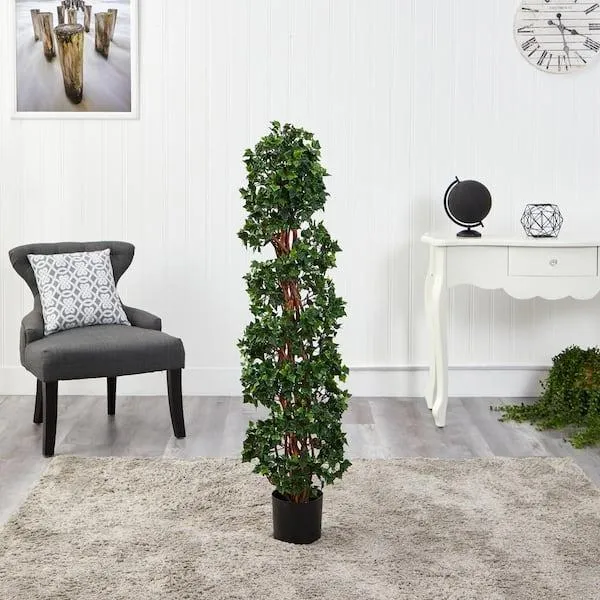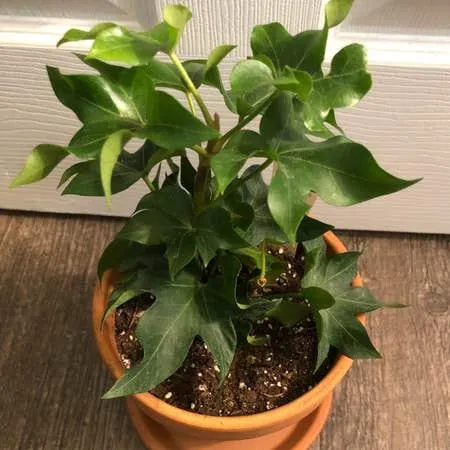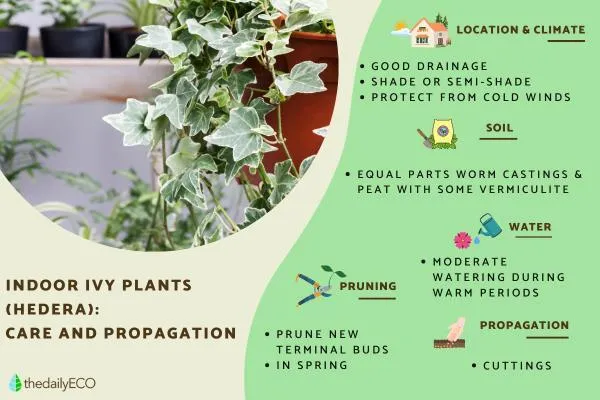
How to Care for English Ivy Indoors: Watering, Light, and Pruning Tips
A Comprehensive Guide to English Ivy Care Indoor
Taking care of English ivy (Hedera helix) as a houseplant isn’t too tricky once you understand its needs. As one of the most popular indoor vines, English ivy can add lovely greenery to your home. But keeping it healthy requires following some basic care guidelines.
Watering English Ivy
Water is crucial for your ivy’s well-being, so monitoring its soil moisture level is important. English ivy prefers consistently moist soil, so check the top inch regularly and water when it starts to dry out. From my experience, ivy needs water every 5-7 days on average. However, this can vary depending on light, humidity, and pot size.
I recommend watering thoroughly until water drains out the bottom holes. This ensures the entire root zone is moistened. Avoid letting ivy sit in water as its roots are prone to rot. Empty any excess water from the saucer within 30 minutes. Under-watering kills more ivies than over-watering, so err on the generous side when watering.
Light Requirements for English Ivy
To thrive, English ivy needs moderate to bright, indirect light. Direct sun can scorch its leaves. However, insufficient light causes leggy growth. I keep my ivy near an east- or west-facing window where it gets 4-6 hours of filtered sunlight daily.
Supplement lighting may help if your home doesn’t get enough natural brightness. A grow light a few inches above your ivy for 10-12 hours per day should suffice. Remember ivies come from shady woodlands, so “low and slow” light is best. Position lights or windows carefully to avoid sunburn as leaves can get singed suddenly.

Fertilizing English Ivy
Feeding your ivy every 4-6 weeks during spring and summer provides nutrients for healthy growth. A balanced, water-soluble houseplant fertilizer diluted to half the recommended strength works well. Scrub the leaves weekly with a damp cloth to remove dust, promoting photosynthesis. Contrary to popular belief, English ivy is not an air purifier, so don’t depend on it for indoor air cleaning.
Pruning and Training English Ivy
Unlike outdoor varieties that can climb trees, indoor ivies require guidance. You can train yours into an attractive weeping shape on poles or trellises. Gently pinch or snip new shoots that grow vertically upwards to encourage spreading. Ivy produces adventitious roots along stems, so pruning sections and propping them up yields full, bushy specimens faster.
Repotting English Ivy
Repot ivy every 2-3 years or when roots fill and circle the nursery pot. Up-potting just one size larger is sufficient. Use a well-draining soil like potting mix or cactus soil amended with perlite or orchid bark for drainage. Rinse old soil off roots before replanting in a clean container with drainage holes. Stake or stake-train the vines after repotting until established.
Pests and Diseases of English Ivy
Ensure good care practices to minimize issues. The main pest, spider mites, shows as tiny dots or webbing and calls for strong rinsing and pesticide treatment as a last resort. Mealybugs manifest as fluffy white masses that suck sap. Quarantine infected plants. Fungal leaf spots result from poor drainage or low humidity; improve conditions to curb spread. Scales appear as hard, waxy bumps which require insecticidal soap.
Temperature and Humidity for English Ivy
English ivy thrives at average room temperatures between 60-75°F. Avoid sudden temperature fluctuations. Many homes feel too hot and dry in winter for ivies, so provide supplemental humidity. A pebble tray, humidifier or grouping plants together boosts moisture to 50-60% ideally. Infrequent misting also refreshes foliage. Indoor ivy appreciates a winter rest period with reduced water and no fertilizer below 60°F.

Propagating English Ivy Cuttings
Taking clippings allows multiplying your ivy without investing in new plants. Simply cut 4-6 inch sections with 2-3 leaf nodes and 1-2 leaves. Remove lower leaves, dip stem ends in rooting powder and plant in moist soil. Spray and enclose cuttings to retain humidity. Roots usually form within 4 weeks. Once established without wilting, pot cutting on its own. This “divide and conquer” approach results in fuller containers long-term.
Dealing with Ivy Indoor Problems
Here are some remedies for common issues:
- Leggy vines – Prune back to encourage bushier growth from nodes.
- Yellowing leaves – Check moisture, light and feed with fertilizer as needed.
- Brown leaf tips – Sign of irregular watering; water evenly when dry an inch down.
- Leaf drop – May be due to temperature shock, low humidity or pests; improve conditions.
- Slow growth – May lack nutrients, light or warmth; adjust care and be patient.
With some TLC, English ivy makes a versatile, low-maintenance houseplant. Just provide the right growing conditions and it rewards you with luscious greenery indoors. Let me know if you have any other ivy care questions!
Indoor English Ivy Care Guide
| Light Needs | Soil | Water | Fertilizer | Pruning |
|---|---|---|---|---|
| Bright, indirect light. Avoid direct sun | Well-draining potting mix. Moist but not soggy | Allow soil to dry slightly between waterings. Water whenever top inch of soil is dry | Feed monthly in spring and summer with diluted liquid fertilizer | Trim as needed to control size and shape. Cut back any vines that grow too long |
| Tolerates low light but will grow more slowly | Pot should have drainage holes | Mist leaves to increase humidity | Too much fertilizer can burn leaves | Prune any dead or diseased parts |
| Will climb or trail dependent on support | Well-draining soil mixes for plants or cacti work well | Avoid overwatering as English ivy is susceptible to root rot | Fertilize less in winter when growth is slower | Ivy can be shaped or trained onto a trellis or figure |
FAQ
-
How do I care for english ivy indoors?
Basically, english ivy needs bright, indirect sunlight and consistently moist soil to thrive indoors. Water whenever the top inch of soil dries out. You can also mist the leaves occasionally. Prune off any areas that appear brown or diseased. Keep it in a drafty spot and it may even grow little vines!
-
What kind of soil and pot should I use?
Any well-draining potting soil will work fine. However, english ivy seems to really like pots with drainage holes so excess water can escape. Terra cotta or plastic works well. As for size, go big – ivy likes to spread out those beautiful glossy leaves. Maybe invest in a hanging basket too for extra vines!

-
How much sun does english ivy need?
English ivy sort of needs bright, indirect sunlight. Direct sun may scorch the leaves. Put it in a spot with morning or afternoon sun, perhaps near a partly sunny window. You can also use a grow light if natural light is limited. Too much shade and the leaves may lose their vibrant green color. Have you tried moving it around to see what it prefers?
-
Why are some of the leaves turning yellow?
Yellow leaves generally mean the ivy is not getting enough water. Be sure the soil stays consistently moist. At the same time, soggy soil can also cause issues. Somehow ivy knows exactly how to drive us crazy! Perhaps the pot is too small as well. On the other hand, it could just be adjusting to a new spot. Give it some time and tlc – the leaves may bounce back yet.
-
How do I prune english ivy?
You can trim off any spindly or diseased areas with pruning shears whenever needed. Cut just above a leaf node. This encourages thicker growth. For a bushier look, trim off the long vines that crawl along the surface. Come spring, give it a light shape-up once new growth appears. Just don’t overdo it or you may shock the plant. With a little haircut now and then, ivy will stay full and good looking for years.
-
Will english ivy be poisonous to pets?
While english ivy is not highly toxic, it could cause tummy trouble for pets that decide to nibble on it. The sap contains calcium oxalate crystals that can irritate mouths. It’s best to place ivy up high or behind a child gate if furry friends are around. You don’t want to come home to a chewed-up plant! Maybe try asking your vet if you have serious concerns about pet safety.
-
Is this indoor ivy getting too big?
If ivy has completely taken over its pot or hangs over the edges, it’s probably time to re-pot into something larger. Shockingly, ivy can become truly enormous if allowed to ramble freely. You can trim roots and fit it into a broader, deeper container with fresh soil. Ivy enjoys being just slightly rootbound. Or try dividing it between two or more pots. With human help or not, ivy basically does what ivy wants!
